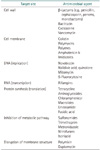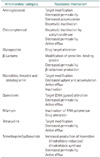Abstract
Antimicrobials were one of the great invention of modern era. However, the abuse of antimicrobial both in human and animals has led to a high rate of occurrence of antimicrobial resistant microbes. Disease treatment caused by antimicrobial resistant microbes including superbacteria has emerged as critical issue worldwide. Communication and cooperation among researchers in diverse fields are needed to solve the resistance to antimicrobials. Culture Collection of Antimicrobial Resistant Microbes (CCARM) has taken a leadership role an intermediary among various research fields by providing certified antimicrobial resistant microbes with their information since 1999. CCARM collects antimicrobial resistant microbes from clinical, agricultural animals and products, and environmental fields, and classifies and stores them according to their origins, species and antimicrobial resistance mechanisms. CCARM is performing the roles (collection, deposit, preservation, distribution, service, and consulting) of Biological Resource Center designated by Organisation for Economic Co-operation and Development.
Figures and Tables
References
1. Kang CS. Antibiotic resistance and countermeasures. Patent 21. 2004; 54:37–43.
2. Jevons MP. “Celbenin”: resistant Staphylococci. Br Med J. 1961; 1:124–125.
3. Jung SS. Antimicrobial resistance mechanism. Korean J Fam Med. 1995; 16:258–271.
4. Song JH, Hsueh PR, Chung DR, Ko KS, Kang CI, Jung SI. Spread of methicillin-resistant Staphylococcus aureus between the community and the hospitals in Asian countries: an ANSORP study. J Antimicrob Chemother. 2011; 66:1061–1069.

5. Ra KT. The rise of antimicrobial resistance. Global Soc Policy Brief. 2016; 20:1–4.
6. Tenover FC. Mechanisms of antimicrobial resistance in bacteria. Am J Med. 2006; 119:6 Suppl 1. S3–S10.

7. Yao DC, Moellering RC. Antibacterial agents. In : Murray PR, Baron EJ, Pfaller MA, Tenover FC, Yolken RH, editors. Manual of clinical microbiology. Washington, DC: American Society of Microbiology;1999. p. 1474–1504.
8. Quintiliani R, Sahm DF, Courvalin P. Mechanism of resistance to antimicrobial agents. In : Murray PR, Baron EJ, Pfaller MA, Tenover FC, Yolken RH, editors. Manual of clinical microbiology. Washington, DC: American Society of Microbiology;1999. p. 1505–1525.
9. Alekshun MN, Levy SB. Molecular mechanisms of antibacterial multidrug resistance. Cell. 2007; 128:1037–1050.

11. Stokes HW, Gillings MR. Gene flow, mobile genetic elements and the recruitment of antibiotic resistance genes into Gram-negative pathogens. FEMS Microbiol Rev. 2011; 35:790–819.

12. Toprak E, Veres A, Michel JB, Chait R, Hartl DL, Kishony R. Evolutionary paths to antibiotic resistance under dynamically sustained drug selection. Nat Genet. 2011; 44:101–105.

13. Voss A, Doebbeling BN. The worldwide prevalence of methicillin-resistant Staphylococcus aureus. Int J Antimicrob Agents. 1995; 5:101–106.

15. Magiorakos AP, Srinivasan A, Carey RB, Carmeli Y, Falagas ME, Giske CG, et al. Multidrug-resistant, extensively drug-resistant and pandrug-resistant bacteria: an international expert proposal for interim standard definitions for acquired resistance. Clin Microbiol Infect. 2012; 18:268–281.

16. Nordmann P, Poirel L, Carrer A, Toleman MA, Walsh TR. How to detect NDM-1 producers. J Clin Microbiol. 2011; 49:718–721.

17. Yoon YE. Superbacteria infection and its countermeasures. BRIC View [Internet]. 2016. 07. cited 2017 Jun 20. 2016-T14. Available from http://www.ibric.org/myboard/read.php?Board=report&id=2539.
18. Last-line antibiotics are failing [Internet]. Medical Xpress;2016. cited 2016 Nov 30. Available from: http://medicalxpress.com/news/2016-11-last-line-antibiotics.html.
19. World Health Organization. Global antimicrobial resistance surveillance system: manual for early implementation. Geneva: World Health Organization;2015.




 PDF
PDF ePub
ePub Citation
Citation Print
Print




 XML Download
XML Download